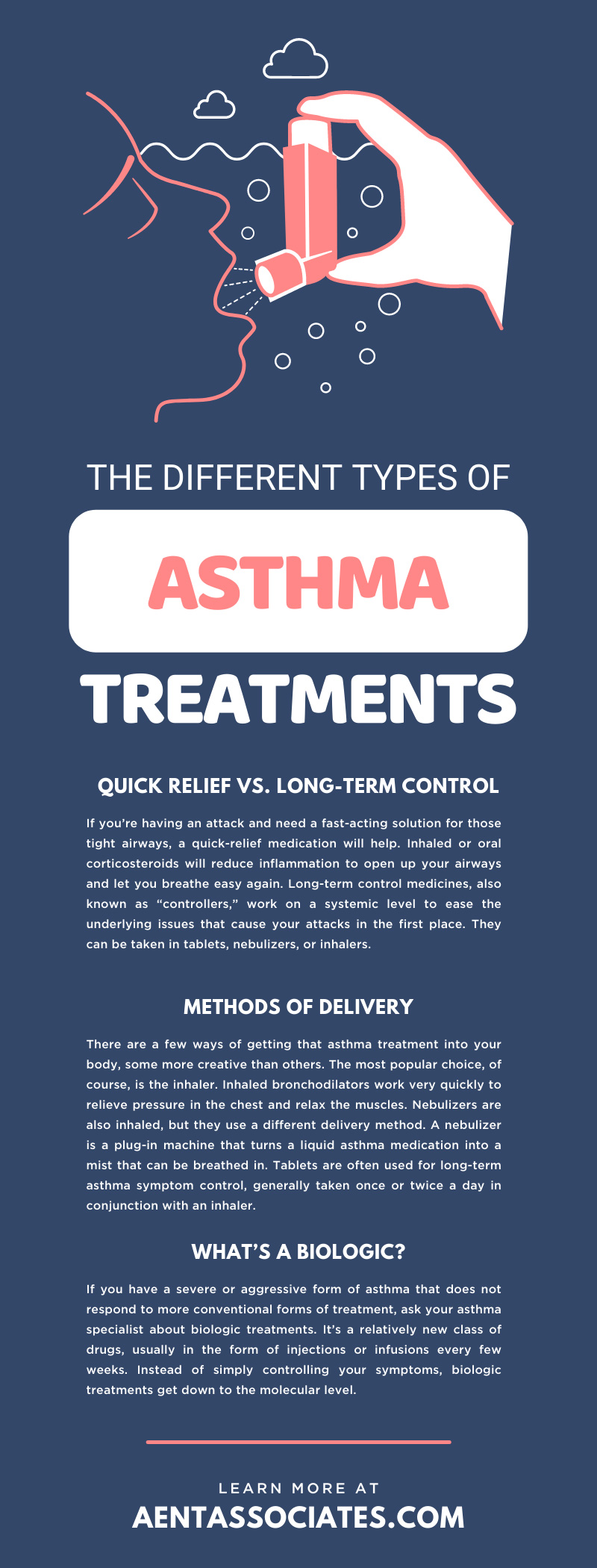
When left untreated, asthma can have a devastating effect on your life. Luckily, you’ve got a plethora of effective treatments to choose from! Visit an asthma specialist near you and work together to test out different types of treatment. Depending on your age and the nature of your asthma symptoms, you may respond better to some treatments over others. Regardless of the ultimate action plan you choose, it’s wise to know about the different types of asthma treatments and what they can do for you. Let’s look at some of the most common treatments.
Quick Relief vs. Long-Term Control
Much like an EpiPen is only a temporary solution for an allergic reaction, some asthma medications are only meant to relieve symptoms in the short term. If you’re having an attack and need a fast-acting solution for those tight airways, a quick-relief medication will help. Inhaled or oral corticosteroids will reduce inflammation to open up your airways and let you breathe easy again. One of the most popular choices for quick relief is a short-acting beta2-agonist, also known as a SABA. It’s a bronchodilator, which means it works on a cellular level to relax the smooth muscles in your lungs. SABAs are most often found in inhaler form and take between five and 10 minutes to work. A short-acting inhaler is meant for emergencies; if you’re using it more than twice a week, talk to your doctor about a more aggressive long-term treatment.
Long-term control medicines, also known as “controllers,” work on a systemic level to ease the underlying issues that cause your attacks in the first place. They can be taken in tablets, nebulizers, or inhalers. There’s a whole category of bronchodilators meant for long-term use, and they are only to be taken in conjunction with an inhaled steroid. If you are prescribed a long-term bronchodilator medicine, use it only as directed.
Methods of Delivery
There are a few ways of getting that asthma treatment into your body, some more creative than others. The most popular choice, of course, is the inhaler. Inhaled bronchodilators work very quickly to relieve pressure in the chest and relax the muscles. They fall into three main categories we briefly touched on above: relief, prevention, and combination. Relief inhalers are those short-term solutions for sudden attacks, while preventative inhalers are taken twice a day for constant symptom management. Some people do need a combination of both in their inhaler.
If you do use an inhaler, look at its type to see how it works. There are four main varieties, and each delivers the medicine differently. A metered-dose inhaler (MDI) works with a propellant to give you a short, controlled burst of your medicine—you can’t accidentally inhale too much. A dry powder inhaler (DPI) doesn’t have any propellant; rather, it releases the medicine when you breathe it in. Breath-actuated inhalers are similar to DPIs, with a powdered or aerosolized medicine that you breathe in with no propellant. Finally, a soft mist inhaler sprays a little cloud of aerosol medicine with no propellant necessary.
Nebulizers are also inhaled, but they use a different delivery method. A nebulizer is a plug-in machine that turns a liquid asthma medication into a mist that can be breathed in. The machine comes with a mouthpiece or face mask that’s worn for up to 10 minutes while the patient breathes in the medicated mist. Nebulizers are popular options for children, as they’re automatic and easy to use. No huffing or puffing necessary—just gentle, deep breaths for a few minutes.
Tablets are often used for long-term asthma symptom control, generally taken once or twice a day in conjunction with an inhaler. A leukotriene receptor antagonist (LTRA) is a type of non-steroidal drug that reduces inflammation and is often used alongside an inhaler. LTRAs reduce the need for your relief inhaler and prevent your lungs from getting stressed out during exercise. Another option is theophylline, which is a non-steroidal bronchodilator that can ease nighttime symptoms in particular. It comes in tablet, capsule, or syrup form, and is particularly effective in treating mild forms of asthma. If none of these tablet-based asthma treatment options work for you, ask your doctor about steroidal treatments to take care of that inflammation more quickly.
Particularly strong forms of asthma may respond better to biologic injections if none of the above methods have proven effective.
What’s a Biologic?
If you have a severe or aggressive form of asthma that does not respond to more conventional forms of treatment, ask your asthma specialist about biologic treatments. It’s a relatively new class of drugs, usually in the form of injections or infusions every few weeks. Instead of simply controlling your symptoms, biologic treatments get down to the molecular level. They target the specific substances that cause your asthma symptoms and latch onto problematic cells. Ask your doctor if a biologic is right for you if you have asthma that doesn’t respond to inhalers or tablets—especially if your attacks are brought on by allergies.
Allergy-related asthma can be hard to treat; after all, how do you quickly stop a haywire immune response? Omalizumab specifically targets allergen-related antibodies and reduces the activity of immunoglobulin E (IgE), which is what sets off that swelling and itching.
If you have eosinophilic asthma, a biologic like mepolizumab might work. Eosinophils are a type of white blood cell that fights off disease by causing inflammation. They can be useful when you’re sick, but if you have too many eosinophils in your system, they cause too much unnecessary swelling. Biologic drugs are known to be effective in treating this tricky variety of asthma.
When you look for effective treatments for your asthma, think about your specific symptoms and how you’d like to treat them. Contact an asthma specialist at Allergy & ENT Associates, the top practice in the Houston area for allergy and asthma woes. Our team of doctors is empathetic to your pain and frustration, and we’re happy to walk you through all of the different types of asthma treatments. Learn which option might be right for you by giving us a call today.




